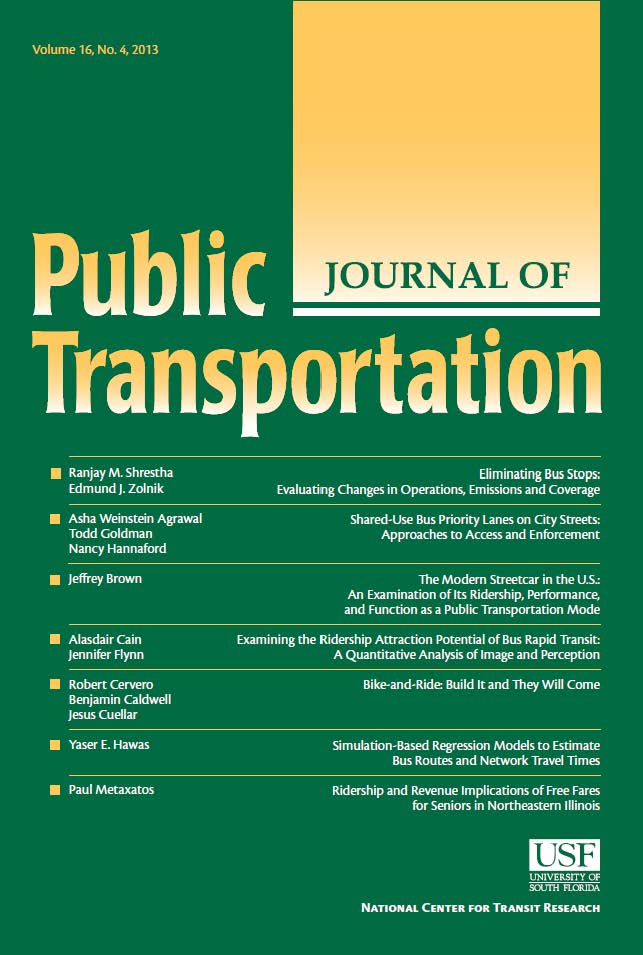Benefits from a new transit line: Exploring the impact of rare users and spatially heterogeneous variations in intensity of use
IF 2
4区 工程技术
Q3 TRANSPORTATION
引用次数: 0
Abstract
What are the city-wide benefits of introducing a new transit mode? Justification of a new transit mode is often based on claims of transformational change regarding mode share, ridership, or passenger-kilometers travelled (PKT). Detractors argue that these dramatic benefits are not experienced uniformly across populations or places. This paper quantifies the extent and intensity of the change in travel behaviour caused by the addition of a new mode and builds on measures of increased ridership and PKT to explore who is travelling on the new mode and in what ways. Recent advances in smartcard data analysis provide detailed insights into transit ridership but are often temporally limited, restricting the ability to analyse long-term behavioural trends. While research on transit ridership patterns exists, few studies compare users of the old and new modes in terms of spatial distribution and intensity of use. This study relies on a long baseline of data to estimate the home locations of travellers and their intensity of use. Our findings challenge assumptions about infrequent users and reveal that rare users significantly influence ridership patterns. Increased reach of ridership is substantiated based on the appearance of new cards 48 % higher than usual after the light rail introduction. However, only about 4 % of new card IDs make trips at a rate equivalent to a daily commute. The results show strong spatial patterns, with 50 % of frequent light rail riders having inferred home locations at the new stations and 63 % of daily riders not using the bus to access the light rail. This approach suggests that (1) rare users, though they ride less often, have a notable impact on ridership trends; (2) transit-access distances are shorter than conventional assumptions of approximately half-a-mile; and (3) ridership benefits show strong spatial patterns.
新交通线路的好处:探索罕见用户的影响和使用强度的空间异质性变化
引入一种新的交通方式对整个城市有什么好处?一种新的交通方式的正当性通常是基于对模式共享、客流量或乘客公里数(PKT)的转型变革的主张。批评者认为,这些巨大的好处并不是在不同的人群或地区都能享受到的。本文量化了增加一种新模式所引起的出行行为变化的程度和强度,并以增加的乘客量和PKT为基础,探索谁在使用新模式以及以何种方式出行。智能卡数据分析的最新进展提供了对公交乘客的详细见解,但往往是暂时的,限制了分析长期行为趋势的能力。虽然有关于交通出行模式的研究,但很少有研究比较新旧交通方式的用户在空间分布和使用强度方面的差异。这项研究依靠一长串基线数据来估计旅行者的住所及其使用强度。我们的研究结果挑战了关于非频繁用户的假设,并揭示了罕见用户对乘客模式的显著影响。在轻轨引入后,新卡的出现证实了乘客人数的增加,比平时高出48% %。然而,只有大约4% %的新身份证的出行速度相当于每天的通勤速度。结果显示出强烈的空间模式,50% %的经常乘坐轻轨的乘客在新车站推断出了他们的家的位置,63% %的日常乘客不使用公共汽车访问轻轨。这种方法表明:(1)稀有用户,尽管他们骑行的频率较低,但对骑行趋势有显著影响;(2)公交通道距离比传统假设的大约半英里短;(3)客流量效益表现出较强的空间格局。
本文章由计算机程序翻译,如有差异,请以英文原文为准。
求助全文
约1分钟内获得全文
求助全文
来源期刊

Journal of Public Transportation
TRANSPORTATION-
CiteScore
6.40
自引率
0.00%
发文量
29
审稿时长
26 days
期刊介绍:
The Journal of Public Transportation, affiliated with the Center for Urban Transportation Research, is an international peer-reviewed open access journal focused on various forms of public transportation. It publishes original research from diverse academic disciplines, including engineering, economics, planning, and policy, emphasizing innovative solutions to transportation challenges. Content covers mobility services available to the general public, such as line-based services and shared fleets, offering insights beneficial to passengers, agencies, service providers, and communities.
 求助内容:
求助内容: 应助结果提醒方式:
应助结果提醒方式:


